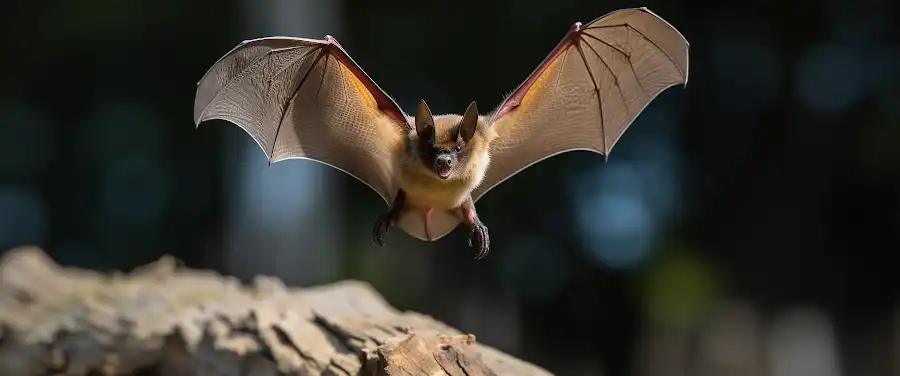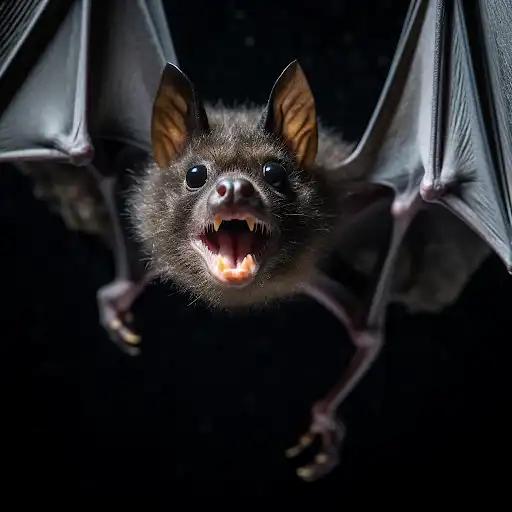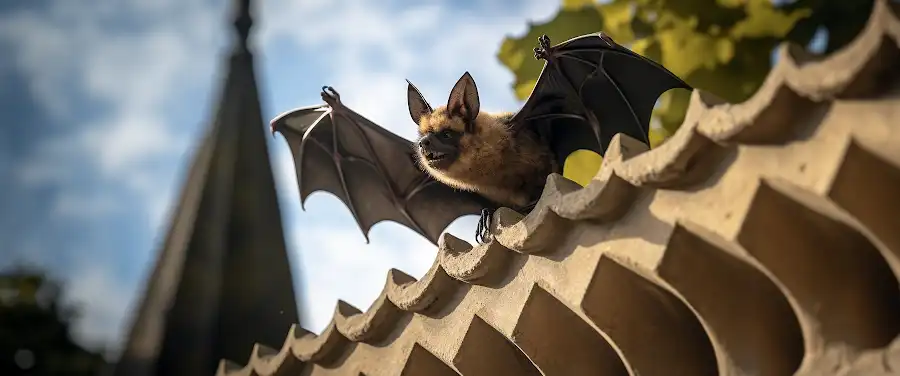
Imagine sitting peacefully in your living room, lost in a fascinating book or a gripping TV show. Suddenly, an almost invisible invader swoops down, unsettling your peace. No, we’re not talking about ghosts or unseen beings from the afterlife; we’re talking about bats. The villains of many a horror movie, bats are often resented for their eerie, unsettling presence and even more so for the potential damage they can wreak on our properties. In understanding bat behavior and the havoc they can rally on your property, it’s evident that these nighttime nuisances are not to be underestimated.
Why should you pay heed you ask? Well, the truth is, despite their small size and seemingly harmless nature, bats can be a significant cause of property damage. You might not immediately notice it, as bats are nocturnal, and many of us prefer keeping a safe distance. Still, over time, their presence can lead to surprisingly significant deterioration of our homes or commercial properties. The smallest corners, the unseen nooks, and crannies, the places least expected, can turn into hot spots for bat damage.
Embracing the proverb ‘knowledge is power’, let’s delve into the world of these unseen invaders. From understanding the ways they can cause harm, to knowing how to safeguard your property, all of it begins with acknowledging the issue at hand. Understanding bat behavior isn’t just for animal lovers or wildlife researchers, it’s essential for every property owner too. Structural stability, health implications, and financial security; if these matter to your life, well, then bats and their behavior should matter too. But hey, we don’t mean to create bat-phobia here, but simply trying to emphasize that when it comes to property safety – being in the know sure helps!
Now that we’ve summoned your attention, let’s gear up to dive a bit deeper. Next up, we’re going to discuss “What are Bats?” in depth. Trust us, there’s more to them than just spooky Halloween decorations!
How Do Bats Enter Your Property?

“Just as Bruce Wayne transformed into the iconic Batman, there’s a silent transformation happening right within our homes and businesses. But unlike our beloved comic book hero, these intruders aren’t there to keep us safe. We’re talking about bats and their potential for damage to your property.
The Most Common Entry Points for Bats
Bats find their way onto properties through various entry points. Their small, flat bodies allow them to squeeze through spaces as tiny as a quarter’s size, making bat entry points numerous and often difficult to spot. Some of the general areas they target include crack and crevices in walls, unclosed windows, and unsealed lofts or attics.
Conditions That Attract Bats to Properties
Bats aren’t just picky about their entry points; they’re quite choosy about their habitats. Conditions that encourage bat migration to properties include plenty of food sources (insects), close proximity to water bodies, and a quiet environment, mostly undisturbed by human activity.
The Frequent Times Bats Migrate to Properties
More often than not, bats choose to migrate to new habitats around dusk or dawn, taking advantage of the dark to move unnoticed. However, it’s important to note that different species behave differently, so these patterns aren’t set in stone.
Overall, they’re most likely to migrate in late summer and early autumn, when they’re in search of warm places to hibernate. More details on bat habits can be found on the National Wildlife Federation website.
Understanding bats and human habitation allows us to take steps in preventing their intrusion. Now, let’s delve into how these creatures can damage your property.”
What Kind of Damage Can Bats Cause to Your Property?

When it comes to property preservation, bats can be a real cause of concern. Many homeowners may think of them as an unseen nuisance, but the damage they can cause is very real and in some cases, substantial. It’s not just about the eeriness they bring, it’s about understanding the different types of damage these nocturnal creatures can cause. After all, knowledge is power. So let’s dive into this gloomy, yet intriguing world and understand just how bats can damage your property.
For starters, one of the most noticeable forms of damage is aesthetic. But we’re not just talking about bat sightings here. Bat urine and droppings, collectively known as guano, can cause significant staining on your building’s exterior. Over time, this leads to discoloration and foul odor, which can reduce the appeal and value of your property.
Moving a step deeper, guano is not only unpleasant to look at, but it’s also highly corrosive. Bat droppings can result in corrosion of metal and other materials if not cleaned up regularly. While this may seem trivial initially, over time it can lead to compromised structural integrity of your building, leading to potential safety risks and increased maintenance costs.
Bats are also notorious for finding their way into every cranny and crevice. This means your home’s ventilation system is not safe either. Bats nesting and living in your ducts can lead to blockages, malfunctions, and prevent proper airflow. The bat activities have a far-reaching impact, affecting indoor air quality, and potentially leading to higher utility bills from inefficient heating and cooling.
But it doesn’t stop there. With the risk of getting too scary, we have to warn you about an even more frightening risk that bats bring to your abode – the risk of electrical fires. Bats are known to chew on wires, and when a bat, wire, and potentially flammable nesting material meet, it can result in a dangerous situation. Disturbingly, fire departments across the United States respond to a number of bat-related fire risks every year.
We’ve covered the physical damages, but don’t underestimate these creatures’ ability to cause lasting damage to your property. It’s essential to regularly check your spaces for signs of bat activities and seek professional help if necessary.
Read more about bats and their habits from National Geographic for expanding your knowledge further.
Now that we’re on the same page about the potential property damages, let’s take a detour and discuss another significant aspect, and that’s about the health risks associated with bats on your property. Let’s see what these winged nocturnal visitors bring along, aside from their distinctive echolocation calls.
What Are the Health Risks Associated with Bats on Your Property?

Have you ever woken up to the sound of bats fluttering around your attic? If so, you might be wondering, “How Bats Can Damage Your Property?” Bats, while beneficial for the ecosystem and insect control, can pose several health risks when they decide to make your property their home. Below, we will delve into the different health issues these winged creatures can bring about, from bat-borne diseases to air contamination and beyond.
Bat-Borne Diseases: A Silent Threat
One of the most significant health risks associated with bats is the diseases they can carry. Notably, bats have been known to transmit rabies, a deadly disease affecting the nervous system, which they can pass on to humans through bites or scratches. CDC reports show that the majority of rabies cases in the United States come from bats.
Another disease associated with bats is histoplasmosis, an infection caused by breathing in spores of a fungus often found in bat droppings. This disease primarily affects the lungs, but severe cases can spread to other parts of the body.
In The Air: How Bats Can Pollute Your Air
Besides diseases, bat droppings, also known as guano, can be quite hazardous. When the guano dries up, it can disintegrate and become airborne, potentially leading to air contamination. Inhalation of these tiny particles can cause respiratory issues like histoplasmosis, especially in those with weak immune systems.
Allergies and Bat Droppings: This Could Be An Issue
Apart from causing diseases, bat droppings might also be responsible for several allergic reactions. Many individuals are sensitive to bat droppings, experiencing symptoms like coughing, wheezing, skin rash, and red eyes.
Bat-Induced Parasitism: What You Need To Know
Last but not least, bats can introduce parasites such as fleas, ticks, and mites into your home, further putting you and your family’s health at risk. These parasites can cause diseases in humans, ranging from mild irritations to serious illnesses like Lyme disease.
In conclusion, bats indeed pose a significant risk to our health, making it crucial to ensure they do not reside in our living spaces. Remember, it’s crucial to maintain a professional to handle these issues, as bats are protected by law in many areas. For more detailed information on bat-related diseases and prevention, check out this article by CDC.
In our next section, we’ll be looking at “How Do You Know You Have Bats in Your Property?“, so you can identify early signs and take necessary precautions. After all, prevention is better than cure. So, let’s delve deeper into understanding more about our winged friends – or shall we say, foes?
How Do You Know You Have Bats in Your Property?

If you’ve ever wondered, ‘How can bats damage my property?‘, the answer isn’t as straightforward as you might think. Bats, despite their rather misunderstood and maligned status in many cultures, can pose a significant threat to your property. While they’re not known for gnawing holes or ripping apart insulation like rodents, they have their unique set of indications.
One might think that spotting a flight of bats in the twilight is a sure-fire way of knowing you have a bat problem. But bats are secretive and nocturnal creatures, often making their presence known through more subtle cues such as noise, droppings (known as guano), and distinctive odors. Let’s dive a little deeper into the telltale signs of bat presence in your property.
The Symphony of Night Whispers – Bat Noise
If your nights are disturbed by chirping, scratching, or rustling sounds, especially from your walls, attic, or chimneys, you might be providing shelter to a colony of bats. Often, these noises increase around dusk or dawn when the bats prepare to exit or return to their roost. Keep in mind that bats make a wide range of noises, so multiple types of sounds might suggest their presence.
Souvenirs from Above – Bat Droppings (Guano)
Guano or bat droppings are a textbook sign of bats living in your property. It usually piles up beneath the roost and might be seen on windowsills, walls, or porches. Unlike rodent droppings, guano breaks apart when touched and reveals shiny specks (from undigested insect parts). Additionally, it produces a strong, unpleasant ammonia-like smell, another strong bat-presence indicator.
Skunk-like Stench? It could be Bats – Bat Odor
Bats aren’t exactly famed for their personal hygiene. Consequently, droppings and urine accumulate where bats roost, releasing a strong pungent odor. This skunk-like smell is a telling sign of a sizeable bat colony, so if you’ve noticed this scent around your property, it might be time to investigate.
The Tell-Tale Stains – Bat Stains
Bats leave behind darker stains on walls or at entry or exit points. This is due to the steroid contained in bat droppings that corrodes materials over time, leaving your property walls stained and potentially damaged.
| Sign | Description | Reason |
|---|---|---|
| Noise | Scratching, rustling sounds | Bat activity |
| Droppings (Guano) | Piles of bat droppings | Bat roosting |
| Odor | Unpleasant, strong smell | Bat droppings and urine |
| Stains | Dark stains on walls or surfaces | Corrosive bat droppings |
These signs of bat presence aren’t just an annoyance. They potentially highlight a significant issue considering the damage bats can inflict on your property. That’s why it’s essential to recognize these signs early on, and take appropriate steps before minor telltales morph into a full-blown infestation.
According to Bat Conservation International, bats play critical roles in maintaining various ecosystems by controlling insect populations. While they can be nuisances when they enter lives and properties, understanding their behaviors and characteristics can help address any potential issues proactively.
Recognizing bat presence early is crucial. Stay vigilant and heed the signs because this opens the door to the next step: bat prevention and removal. Ensuring that these benign night fliers don’t turn into anything other than unseen guests becomes so much easier when you know what to look for.
Conclusion
As we come to our conclusion, it’s time to revisit what we’ve learned about how bats can damage your property, and absolutely why this issue is worth your attention. If you are or aspire to be a savvy property owner or manager, this subject should not be taken lightly. Addressing a bat nuisance timely can save you the nightmare of potential property damage, devaluation, and even critical health risks.
Did you ever imagine something as small and elusive as bats could pose such a threat? From undermining your premises’ structural integrity to causing severe health problems, their implications can indeed be damaging. Most people can’t imagine dealing with bats nuisance as a crucial task but as our discussion shows, the possibility of such an encounter should always be on your radar.
What’s essential to keep in mind is that a failure to act can compromise your property’s value. You’ve worked hard to build or maintain your property and it’s only right to safeguard against any unforeseeable issues that bats might cause. Handling this issue properly not only keeps your property intact but also works to preserve property value effectively.
While we talk extensively about property damage, it’s equally vital to be aware of the health aspects related to bats. Remember, bats are known carriers of various diseases, and these bat health risks could potentially impact the inhabitants of your property, causing more setback than could be anticipated.
So, what’s the takeaway here? The ‘out of sight, out of mind’ approach certainly won’t work when it comes to these creatures. It’s all about staying vigilant, being aware, and taking proactive steps when necessary. Keep track of any signs of bat presence or activity in your property and don’t delay seeking professional help if you suspect a bat invasion.
Hence, our final advice on bat issues is simple – let’s not underestimate them. Bats may be unseen and mostly harmless in their natural habitats, but they can cause unseen nuisance and problems in your property. As owners, it’s crucial to understand the impacts, take necessary measures, and ultimately keep our properties safe and free from any bat related risks.
With a little care and attention, you can ensure that bats are not your property’s unwanted guests. Stay informed, stay alert, and make your property bat-free.




